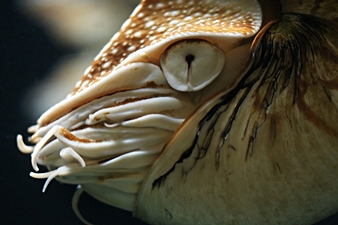Systematic Classification
Class: Cephalopoda
![]() Subclass: Nautiloidea
Subclass: Nautiloidea
![]() Order: Nautilida
Order: Nautilida
![]() Family: Nautilidae
Family: Nautilidae
Source: Tree of Life - Cephalopoda
 Nautilus pompilius (left) and Allonautilus scrobiculatus in Papua New-Guinea. Picture: W. B. Saunders. |
Nautiluses live on the steep slopes of Pacific coral reefs. The common nautilus (Nautilus pompilius) is the most widely spread members of all nautiluses. It occurs from the Andaman Islands in the west as far east as to the Fiji islands, from southern Japan in the north as far south as to the Great Barrier Reef northwest of Australia. Another species, Nautilus belauensis, is home near the islands of the Palau archipelago, in the Pacific north of Indonesia.
Nautiluses are cephalopods. They are different from their living cephalopod relatives, though, in numerous characters, which make them appear like a relic from times long gone:
 Frontal view of a Nautilus pompilius. Picture: Hans Hillewaert (Wikipedia). |
Completely different, say, to an octopus or a squid, a nautilus possesses a hard coiled shell from calcium carbonate. Other than a snail shell, a nautilus shell is chambered inside; the animal itself inhabits only the outermost, apertural chamber. Only a thin string of the nautilus' body, the siphuncle, reaches through the other chambers. It helps the nautilus to change the gas content in each chamber and thus the shell's buoyancy. Less gas in its shell chambers makes the nautilus sink; more will make it climb, just like a submarine blowing the ballast tanks. The nautilus benefits from this by resting in water depths of 100 to 130 feet during the day, but climbing towards the surface in the night on the search for food.
A nautilus' shell mouth or aperture is protected by a hard and resisting lid, which closes the aperture, when the animal withdraws into the shell. If it is open, it becomes obvious, why Nautilus is counted among the cephalopods. There are about ninety tentacles at its disposal to catch prey, mostly small hermit crabs and other crustaceans. As among other cephalopods, the tentacles take the prey towards the mouth, where a beaks already waits to crack their carapace. Except that it has much more of them, a nautilus' tentacles, are also different from those of an octopus or a squid: They are not equipped with suckers. Instead, sticky cilia make adhesive pads, that ensure safe hold on the prey. Each nautilus tentacle, besides, consists of a thin cirrus (the arm as such) which can be withdrawn into s special sheath.
On the lower side of the shell mouth usually also the funnel (siphon) can be seen, like by other cephalopods, also used by Nautilus as a means of fast backward propulsion by squirting out water.
 Nautilus pompilius. Picture: Hans Hillewaert (Wikipedia). |
|
 The head of a Nautilus pompilius. Picture: Hans Hillewaert (Wikipedia). |
Under a nautilus' fleshy shell lid usually also its eyes can be seen. Very much in contrary to the other cephalopods' highly developed lens eyes (in fact the most highly developed eyes among all invertebrates), nautilus' eyes are rather primitive, resembling the function of a camera obscura or pinhole camera, in which sharpness of the picture is achieved by closing the pupil, of course reducing the amount of incoming light. Nautilus eyes are not equipped with a lens.
![]() The Evolution of the Mollusc Eye.
The Evolution of the Mollusc Eye.
Male nautiluses can be recognized by their specialised reproduction organ, the spadix, which is basically made of four specialised tentacles. It is used by the male to transfer a sperm packet to the female.
|
David Attenborough about the Nautilus. Source: YouTube. |
In their natural environment, nautiluses are threatened by many other sea living creatures. Among fish those are mainly triggerfish equipped with powerful teeth to crack the nautilus' shell. But also other cephalopods attack nautiluses, trying to drill in their shells (like they would in a mussel or snail shell) and to poison the nautilus with venom. Assumedly a part of the nautilus' vertical migration during the day is to confuse predators hunting visually.
|
|
Norman, M.: "Cephalopods – A World Guide"; Conch Books 2001. |
Inside the cephalopod class nautiluses and their relatives make an own subclass Nautiloidea, due to their special and often archaic characters (as mentioned above). Among cephalopods, nautiloids are not only among the oldest recent groups (nautilus is a so-called living fossil), but also the oldest fossil groups, the first nautiloids having appeared in the Cambrian, more than 500 million years ago.
 USS Nautilus SSN 571 on her maiden voyage in 1955. Source: Wikipedia. |
Not only on the field of biology, but also in navy history nautilus (from the Greek ναυτιλος for sailor) and its relative cephalopods can be encountered. In 1800 an American inventor, Robert Fulton, presented one of the first submarines to the French and British authorities alike. Though Fulton managed to sink a French and a British ship, neither party was interested.
During the Second World War, two US submarines, USS Nautilus SS 168 and USS Argonaut USS 166, took part in a Special Forces operation to reoccupy the Pacific island of Makin. The first American submarine with nuclear propulsion also was a Nautilus. SN 571 astonished the world (in the time of Soviet success in space due to Sputnik) being the first ship on the North Pole by diving all the way under the Northern polar ice cap under the command of William T. Anderson.
The most famous ship named Nautilus still is fictional. In the 1870 Jules Verne novel it takes Captain Nemo “20000 leagues under the seas" (See also: "The legend of the giant squid").